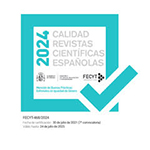Eikón/Imago adopts the Continuous Publication Model
We are pleased to inform our readers and authors that Eikón/Imago is going to adopt, the Continuous Article Publication model (CAP) for its articles and reviews, starting with its next issue (vol. 13 2024).










